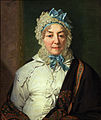Wladimir Lukitsch Borowikowski

Vladimir Borovikovsky ( Russian Владимир Лукич Боровиковский , scientific transliteration. Vladimir Borovikovsky Lukič , Ukrainian Володимир Лукич Боровиковський Volodymyr Lukytsch Borowykowskyj ; born July 24 . Jul / 4. August 1757 greg. In Poltava , † April 6 jul. / April 18 1825 greg. In Saint Petersburg ) was a portrait painter in the service of the Russian court , who is considered the last great exponent of Russian portrait painting at the transition from the 18th to the 19th century.
biography
Vladimir Borovikovsky was born into a family of Ukrainian Cossacks . His father Luka Borowik had a sideline as an icon painter . According to family tradition, all four of his sons served in the Mirgorod Regiment, but Vladimir soon resigned to the rank of lieutenant and devoted his life to art, initially as an icon painter for local churches.
Borowikowski led a quiet provincial life, but an unexpected event gave him a rapid rise. During Catherine the Great's trip to New Russia , his friend Vasily Kapnist prepared her accommodation in Kremenchug and asked Borowikowski to paint two allegorical paintings for her rooms. One of them depicted Peter the Great and Catherine the Great as sowers, and on the other Katharina was shown as Minerva . The Empress liked the paintings so much that she offered the painter to move to Saint Petersburg, which he did in 1787.
After moving, he changed his last name Borowik to Borowikowski to sound more aristocratic. For the first ten years in St. Petersburg he lived in the house of the poet, architect, musician and art theorist Nikolai Lwow , whose ideas had a strong influence on the works of Borovikowsky. By the age of 30 Borowikowski was already too old for the Russian Art Academy , so he took private lessons from Dmitri Levizki and later from the Austrian painter Johann Baptist Lampi .
In 1795 he reached the academic degree and became a successful portrait painter. In the course of his life he created around 500 different portraits, around 400 of which have survived to our day. Borowikowski had his own workshop and delegated the painting of less important details to his assistants. His clients included members of the imperial family, members of the court nobility, generals and people from artistic and literary circles. Many portraits are confidential by their style.
Works (selection)
The most famous works include:
- Portrait of Catherine the Great (1794)
- Portrait of E. Arsenjewa (1796)
- Portrait of M. Lopuchina (1797)
- Portrait of F. Borowski (1799)
- Portrait of Paul I (1800)
- Portrait of Prince A. Kurakin (1801–1802)
- Portrait of the Princesses A. Gagarina and V. Gagarina (1802).
- Portrait of the Serbian Prince Karadjordje (1816).
Borowikowski never taught at the Russian Art Academy, but numerous students who enrolled there lived in his home. Among them were Alexei Venetsianov and Ivan Bugajewski-Blagodarny , who painted the only surviving portrait of Borowikowski.
After 1819 Borowikowski became a Freemason and a member of the Dying Sphinx Lodge . During this time he again mainly painted icons, including the iconostasis for the church at Smolensk cemetery and some icons for the Kazan Cathedral in Saint Petersburg.
On April 6, 1825 Borowikowski died suddenly of a heart attack and was buried in the Smolensk Cemetery in Saint Petersburg.
Works
Portrait of Dmitri Levitsky 1796
Portrait of F. Borowski. 1799
Portrait of Alexander Kurakin ( 1801 - 1802 ).
Portrait of the Grand Duchess Maria Pavlovna . 1800s
Portrait of Gawrila Derschawin . 1811 .
Portrait of S. Rajewskaya. 1813
Portrait of AG and AA Lobanow-Rostowski. 1814 .
Portrait of Prince G. Volkonsky
Portrait of E. Archarova. 1820
Web links
- Online gallery and biography (English)
- Biography (English)
- Online gallery and biography ( Memento from October 13, 2003 in the Internet Archive ) (Russian)
- Vladimir Lukic Borowikowski. Pictures and biography
- Article Wladimir Lukitsch Borowikowski in the Great Soviet Encyclopedia (BSE) , 3rd edition 1969–1978 (Russian)
Individual evidence
- ↑ Napp, Antonia: Russian portraits: Gender difference in painting between 1760 and 1820. Cologne: Böhlau Verlag, 2010. P. 210.
- ↑ Russia's soul: icons, paintings, drawings from the Moscow State Tretyakov Gallery. Art and Exhibition Hall of the Federal Republic of Germany 2007. p. 96.
- ^ Gray, Rosalind P .: Russian Genre Painting in the Nineteenth Century. Oxford University Press 2000. p. 77.
| personal data | |
|---|---|
| SURNAME | Borowikowski, Wladimir Lukitsch |
| ALTERNATIVE NAMES | Боровиковский, Владимир Лукич (Russian); Боровиковський, Володимир Лукич (Ukrainian) |
| BRIEF DESCRIPTION | Russian portrait painter |
| DATE OF BIRTH | 4th August 1757 |
| PLACE OF BIRTH | Mirgorod |
| DATE OF DEATH | April 18, 1825 |
| Place of death | St. Petersburg |












